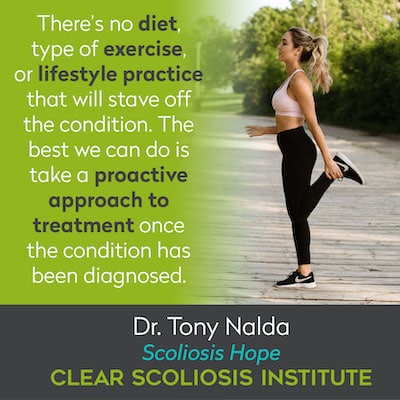
How do you get scoliosis? This is a question frequently asked by individuals who have received a recent scoliosis diagnosis. It is one of many questions that may flood through their mind after their diagnosis. Is it genetic? Was it something I did? Was there something I could have done to prevent it? How do you treat it? What’s next?
Scoliosis is a complex and confusing condition. Throughout this article, we’ll define scoliosis and provide the intricate answer to the question: how do you get scoliosis? We’ll also discuss an even more important question for those who have received a diagnosis: how do you treat scoliosis?

What makes scoliosis complex is that it is a three-dimensional condition of the spine affecting all three planes of the body: front-to-back (sagittal), top-down (axial), and side-to-side (coronal). Since x-rays are two-dimensional, the condition extends beyond what can be seen by the human eye on a traditional x-ray or measured by the Cobb angle, which is considered the orthopedic gold standard for assessing scoliosis curvature.
The severity of scoliosis is determined by looking at the degree of curvature of the spine (the Cobb angle). There are several different ways to classify scoliosis. At CLEAR Scoliosis Institute, we recognize the classification of scoliosis as follows:
No matter what the severity of the scoliosis is, it is important to remember that the Cobb angle is only a two-dimensional measurement of a three-dimensional condition. The CLEAR Approach to analyzing scoliosis involves measurements above and beyond the Cobb angle to ensure the three-dimensional aspect of the spine is taken into consideration.
The answer to the question, how do you get scoliosis, is dependent upon the type of scoliosis that you have. This makes the question semi complex to answer. To best understand the cause, we must first understand the different types, categories, or classifications of scoliosis.
The cause of scoliosis varies based on the type of scoliosis an individual has. There are three main classifications of scoliosis: neuromuscular, congenital, and idiopathic. Subgroup classifications exist; however, they represent a very small percentage of scoliosis cases.
Neuromuscular scoliosis (NMS) is a type of scoliosis that occurs in individuals with conditions that affect the muscles and / or connective tissues that support the spine. “Neuromuscular scoliosis is the second most prevalent spinal deformity (after idiopathic scoliosis) and is usually first identified during early childhood.” [2] The most common conditions associated with NMS are:
According to the American Academy of Orthopaedic Surgeons, “NMS is caused by an underlying medical condition that affects either the body's neurological system or muscular system—or a combination of both.” [3] Individuals with NMS frequently develop scoliosis at a young age. However, NMS only accounts for a small percentage of scoliosis cases.
The table below was developed by the Scoliosis Research Society and shows the incidence of scoliosis for a neuromuscular diagnosis.
Congenital scoliosis is caused by a defect in the spine which is present at birth. “It occurs in only 1 in 10,000 newborns and is much less common than the type of scoliosis that begins in adolescence.” [5] Although the defect is present at birth, individuals may not be diagnosed with scoliosis until later in life.
Idiopathic scoliosis is the most common type of scoliosis. The Merriam-Webster Dictionary defines idiopathic as, “arising spontaneously or from an obscure or unknown cause.” Therefore, idiopathic scoliosis by definition means the cause is unknown.
According to the American Association of Neurological Surgeons, “Idiopathic scoliosis is the diagnosis when all other causes are excluded and comprises about 80 percent of all cases.”
According to CLEAR Senior Fellow Dr. Tony Nalda, “Because we don’t know exactly what causes most cases of scoliosis, we can’t engage in methods to prevent it from occurring. There’s no specific scoliosis diet, type of exercise, or lifestyle practice that will stave off the condition. The best we can do is take a proactive approach to treatment once the condition has been diagnosed.” (Scoliosis Hope, 2019, p.15)

If you’re wondering whether or not scoliosis is genetic, the simple answer is no. There is little evidence to support a genetic link to scoliosis, but it can be described as familial, meaning it can run in families. You can learn more by reading our blog post Does Scoliosis Have a Genetic Component? 
Many parents experience guilt thinking they caused their child’s scoliosis. The truth is, with 80% of the cases being identified as idiopathic with cause unknown, there is likely nothing parents could have done to prevent the scoliosis. The best thing you can do is determine the appropriate course of treatment.
Many experts view the spinal curvature in idiopathic scoliosis cases as a symptom caused by an underlying factor. Like fever, there are many factors that can cause the symptom of a fever. Once the cause of the fever is gone, the fever resolves.
However, unlike a fever, since the curve of the spine already exists, it has become a structural concern. Therefore, even if they could find and remove the cause of the scoliosis, the curve has become a separate problem of its own.
After receiving a scoliosis diagnosis, individuals often wonder what’s next? Many patients are told to watch and wait, pursue traditional bracing, or consider scoliosis surgery. At CLEAR Scoliosis Institute, we have developed an alternative, non-invasive approach to treating scoliosis.
The CLEAR Approach was developed by Dr. Dennis Woggon in 2000 when he founded CLEAR Scoliosis Institute. CLEAR-certified doctors are trained to identify the alternative approach that is best for you by assessing your scoliosis, developing a customized in-clinic treatment plan, and prescribing home exercises specifically for your case that will enhance the results of your in-clinic care.
Since each patient’s scoliosis is different, the care they receive at a CLEAR Scoliosis Center* will be different as well. Treatment sessions often include a three phase approach that was developed by CLEAR Scoliosis Institute, known as Mix, Fix, Set. This includes warm-up exercises, adjustments, and specialized exercises that influence posture, balance, and coordination.
Many individuals considering the CLEAR Approach wonder what type of results CLEAR patients receive. In a study of 189 scoliosis patients over 3198 visits, over 95% of patients reported positive results. [6] The CLEAR Approach has been shown to help patients of all ages. Of the 189 patients surveyed, 109 were adolescents and 80 were adults.
Scoliosis is a three-dimensional condition that often relies on two-dimensional x-rays for diagnosis and treatment; this makes it an extremely complex condition. Because of this, the answer to the question “how do you get scoliosis” isn’t as straightforward as one may think.
The cause of scoliosis depends on the type of scoliosis.
NMS is caused by an underlying condition, congenital scoliosis is caused by a defect present at birth, and with idiopathic scoliosis, the cause is unknown. In fact, over 80% of scoliosis cases are identified as idiopathic scoliosis. So, how do you get scoliosis? We don’t really know.
The truth is, even if we knew the exact cause of scoliosis, the treatment likely wouldn’t change. The traditional approach to treating scoliosis is a three tier approach - watch and wait, bracing, or conder surgery.
At CLEAR Scoliosis Institute, we know there is a better way to treat scoliosis, which is why we’ve developed an alternative, non-invasive approach to treating scoliosis. Whether you have NMS, congenital scoliosis, or idiopathic scoliosis, we recommend finding a CLEAR-certified doctor to learn more about the treatment options available for your scoliosis.
[1] Scoliosis - Symptoms and causes
[3] Diseases & Conditions Neuromuscular Scoliosis
Disclaimer: The author’s views are his or her own and may not reflect the views of CLEAR Scoliosis Institute.

CLEAR provides a unique and innovative way of understanding scoliosis. Sign up to receive facts and information you won’t find anywhere else.

Thanks! This article was really awesome, particularly since I was searching for thoughts on this topic last Sunday.
I was born at home ,breech birth and have bad scoliosis. Have always been self councilors of it. My parents were kinds of backwoods and did not try to get treatment for me. I was born in1944 so treatment was not available as it is today I am now76 yo and know. It is now to late for treatment would love some advice from you.
Hello, Peggy,
Our CLEAR Scoliosis Institute Doctors have treated many patients even into their 80s. Our goal with older scoliosis patients is to reduce pain, increase mobility, and increase stability. I would suggest contacting the CLEAR Scoliosis Center closest to you to determine if you would be a candidate for the type of treatment they provide. To find this information, please visit our website under "Find a Doctor". Best of luck.
Thank you for sharing this very reliable and informative article. I can now avoid scoliosis.